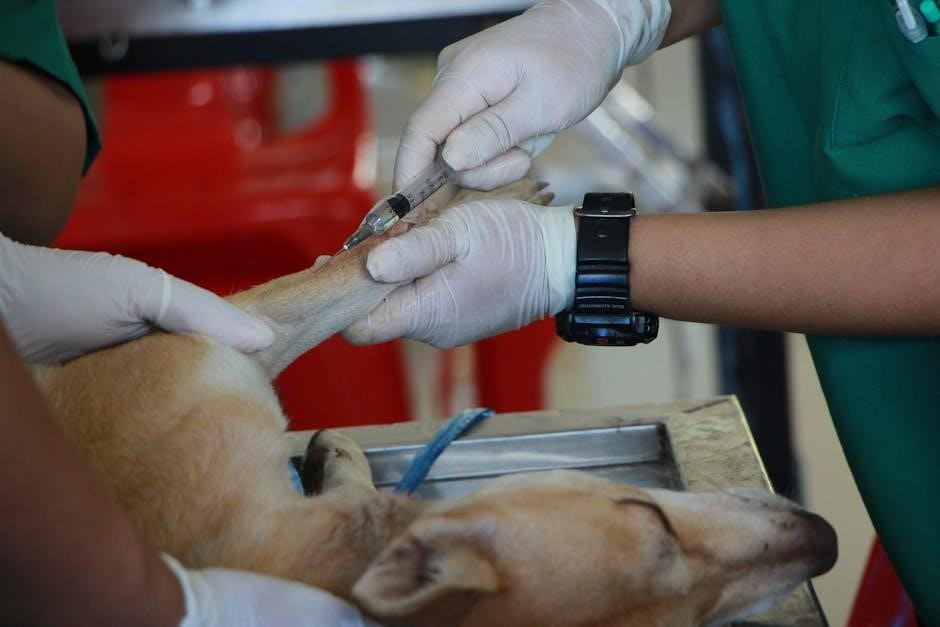CT guided nerve root injection is a medical procedure using
imaging guidance
to administer pain relief medications.
Definition and Purpose
CT guided nerve root injection is defined as a minimally invasive procedure where a needle is guided into the nerve root using CT imaging. The purpose of this procedure is to reduce inflammation and relieve pain in the affected nerve root. This is achieved by injecting medications, such as corticosteroids, into the nerve root. The goal of the procedure is to provide relief from chronic pain and improve mobility. CT guidance allows for precise placement of the needle, increasing the effectiveness of the procedure. The definition and purpose of CT guided nerve root injection are closely related, as the procedure is designed to achieve specific therapeutic goals. By using CT imaging, the procedure can be performed with greater accuracy and safety, making it a valuable treatment option for patients with chronic pain. This procedure has become increasingly popular due to its effectiveness.

Preparation and Procedure
CT guided nerve root injection involves specific preparation and procedural steps always.
Preparation for the Procedure
To prepare for the procedure, patients are typically required to undergo a series of tests and evaluations, including medical history and physical examination.
The radiologist will review the patient’s medical history and perform a physical examination to determine the best approach for the procedure.
Patients may also be required to stop taking certain medications, such as blood thinners, before the procedure to minimize the risk of bleeding.
Additionally, patients may be asked to change into a hospital gown and remove any jewelry or metal objects that may interfere with the CT scanner.
The preparation process is crucial to ensure the procedure is performed safely and effectively, and the patient is properly positioned on the CT scanner table.
The patient’s vital signs, such as heart rate and blood pressure, are monitored throughout the procedure to ensure their safety.
The preparation process typically takes about 30 minutes to an hour to complete, after which the procedure can begin.
The patient is then ready to undergo the CT guided nerve root injection procedure.
CT Guidance and Safety
CT guidance ensures accurate needle placement and minimizes risks during the procedure, using advanced imaging technology for safe injection administration always successfully.
Role of CT Scanning
CT scanning plays a crucial role in guiding the needle to the correct location, allowing for precise administration of medication. The use of CT scanning enables real-time imaging, reducing the risk of complications. This technology provides detailed cross-sectional images of the body, helping to identify the exact location of the nerve root. With CT guidance, the procedure can be performed with increased accuracy, minimizing the risk of injury to surrounding tissues. The role of CT scanning is essential in ensuring the safe and effective administration of the injection, and its use has become a standard practice in this type of procedure. By utilizing CT scanning, healthcare professionals can provide optimal care and achieve the best possible outcomes for patients undergoing nerve root injections, with the goal of relieving pain and improving quality of life.
Indications and Contraindications
CT guided nerve root injection is used to treat various spinal conditions and relieve pain effectively always.
Indications for the Procedure
CT guided nerve root injection is used to treat various spinal conditions, including herniated disks and spinal stenosis, which cause pain and discomfort.
The procedure is also used to diagnose the source of pain, and to determine the best course of treatment.
It is often used to treat conditions that have not responded to other forms of treatment, such as physical therapy or medication.
The procedure can be used to treat pain in the neck, back, and legs, and can be used to treat conditions such as sciatica and spondylosis.
CT guided nerve root injection is a minimally invasive procedure that can be performed on an outpatient basis, and is often used to avoid the need for surgery.
The procedure is typically performed by a radiologist or other trained medical professional, and is considered a safe and effective treatment option.

Potential Complications and Risks
CT guided nerve root injection carries risks of infection and bleeding, and other complications may occur during the procedure, causing discomfort and pain sometimes.
Rare but Severe Complications
Severe complications from CT guided nerve root injection are rare, but can be serious, including spinal ischaemia and neurological sequelae. According to reports, inadvertent injection of corticosteroid into a feeding spinal artery can cause these complications. The risk of these complications is low, but they can have significant consequences for the patient. Specialist radiologists take precautions to minimize the risk of these complications, using imaging guidance to ensure accurate placement of the needle. Despite these precautions, rare but severe complications can still occur, emphasizing the importance of careful patient selection and monitoring. By understanding the potential risks and taking steps to minimize them, patients can make informed decisions about their treatment options and receive the best possible care. CT guided nerve root injection remains a safe and effective procedure for many patients.

Experience and Outcomes
Specialist radiologists have performed numerous CT guided nerve root injections with successful outcomes and minimal complications reported regularly online.
Successful Procedures
CT guided nerve root injection procedures have been successfully performed by specialist radiologists, with many patients experiencing significant pain relief. In these procedures, the use of CT guidance allows for accurate placement of the needle, ensuring that the medication is delivered directly to the affected nerve root. The success of these procedures can be attributed to the expertise of the radiologists and the advanced imaging technology used. With the help of CT guidance, the risk of complications is minimized, and the effectiveness of the treatment is maximized. As a result, patients can expect to experience a significant reduction in pain and inflammation, allowing them to regain mobility and resume their normal activities. Overall, the success of CT guided nerve root injection procedures has made them a popular treatment option for patients suffering from chronic pain.

and Future Directions
CT guided nerve root injection is a promising treatment with ongoing research and development improving outcomes and techniques slowly every day.
Importance of CT Guidance
CT guidance plays a crucial role in ensuring the accuracy and safety of nerve root injections. The use of CT scanning allows for real-time imaging, enabling the radiologist to precisely guide the needle to the targeted nerve root. This reduces the risk of complications and improves the effectiveness of the procedure. With CT guidance, the radiologist can also avoid injecting medication into surrounding tissues or blood vessels, which can lead to adverse reactions. The importance of CT guidance cannot be overstated, as it has been shown to significantly improve patient outcomes and reduce the risk of severe neurological complications. By utilizing CT guidance, radiologists can provide a higher level of care and ensure the best possible results for their patients. This technology has become a essential tool in the field of interventional radiology.
